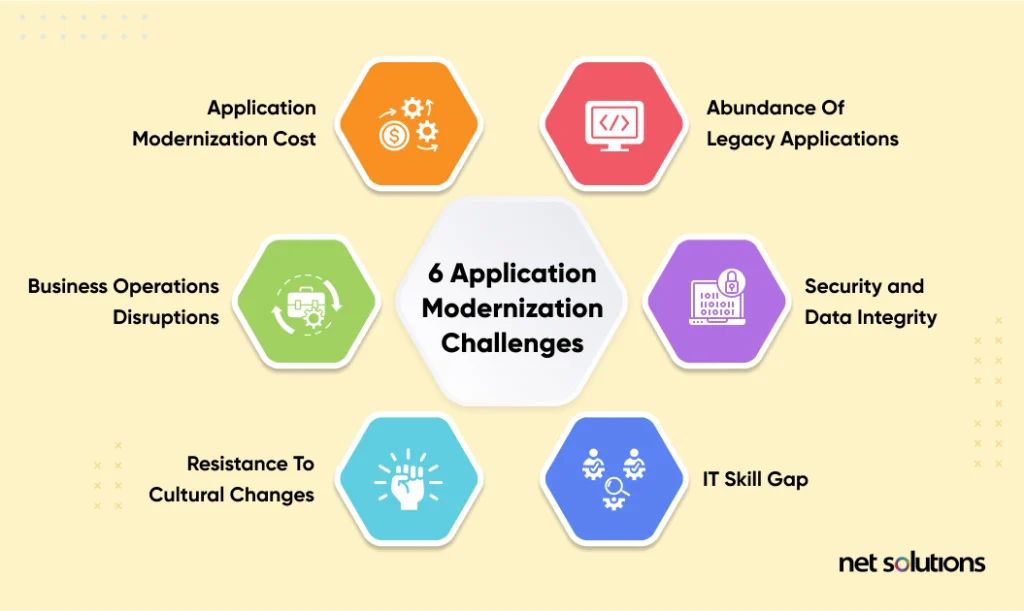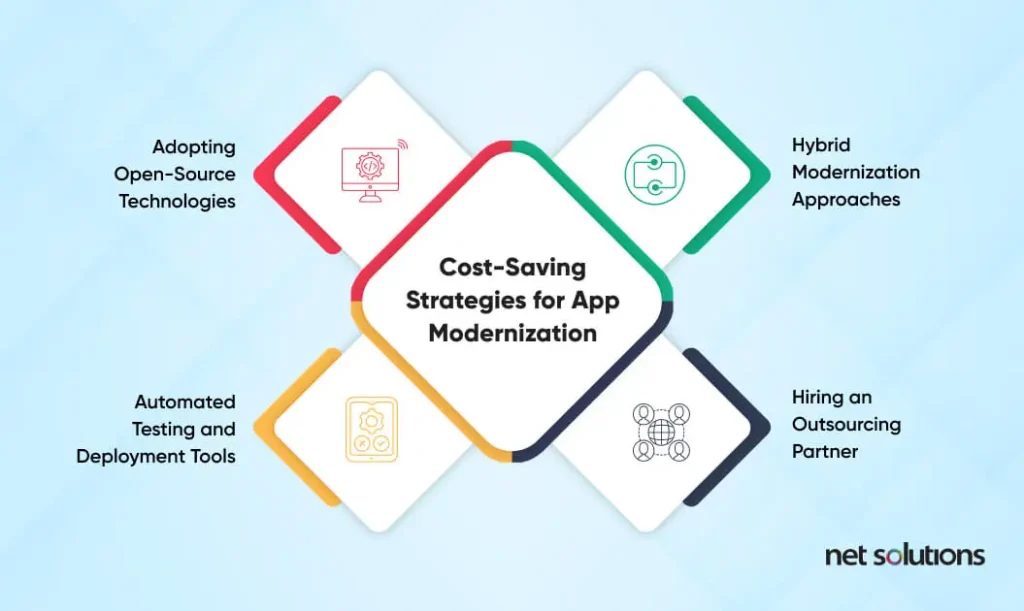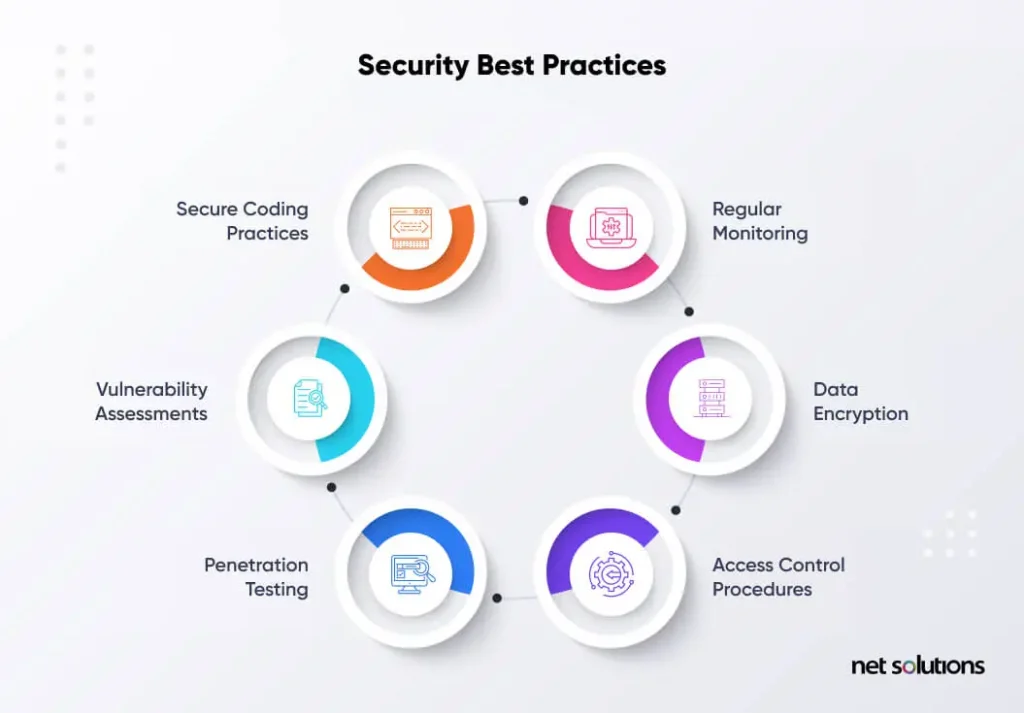Application modernization is vital to any digital transformation, setting the stage for improved functionality, scalability, and IT systems designed to better serve a company’s overall business needs.

Of course, modernizing legacy applications to take advantage of cloud-based architecture comes with its share of challenges. Some common app modernization challenges include:
- Excessive application modernization costs
- An abundance of legacy applications with many dependencies
- Business operations disruptions during the transition
- Security and data integrity challenges
- Resistance to cultural changes within an organization
- Insufficient IT skills required for a successful modernization
When building your app modernization strategy, it’s important to be aware of these challenges and create a plan to address them.
Application Modernization Cost
Even if you’ve set aside a healthy budget for your modernization project, upgrading legacy systems may have some costs that might surprise you. Identifying these potential budget busters up front can help you control them.
Application modernization costs include:
- Infrastructure upgrade costs when moving from on-premises applications to cloud services platforms powered by providers like AWS
- Licensing fees for new, cloud-native software
- Software development costs, including the opportunity costs of diverting internal resources toward application development
- Potential downtime during the cloud migration
It’s important to fully account for all potential costs and develop strategies to mitigate them without sacrificing quality.
Solution: Cost-saving strategies
A well-planned strategy can help you control costs without impacting the success of your modernization efforts.

Here are some ways to control costs when modernizing your legacy apps:
- Adopting open-source technologies (such as OpenStack and CloudStack) when building a modern app ecosystem
- Hybrid modernization approaches that include retaining legacy system elements and wrapping them in an API layer to interact with more modern apps.
- Automated testing and deployment tools can expedite testing and deployment to spot and address potential problems sooner.
- Hiring an outsourcing partner that specializes in digital transformation and application modernization
Each of these strategies can help reduce some of the costs associated with application modernization, so carefully consider each one to decide if it fits well with your modernization process.
Abundance of Legacy Applications
Running a large number of outdated legacy systems is a common challenge that many businesses face. A recent study found that two-thirds of U.S. businesses still use mainframe or legacy apps for key customer-facing operations.
Having excessive monolithic applications makes modernizing two-thirds of U.S. businesses an urgent task. At the same time, it makes it more challenging, given the project’s vast scope.
Here are some challenges associated with having many legacy apps in your ecosystem.
- Struggles with interoperability between existing apps, where countless dependencies exist, and changing one app could directly impact the user experience.
- Maintenance costs can soar with legacy systems due to the need for workaround solutions that often result in technical debt and may produce costly security issues.
- Integration challenges between legacy and modern apps make using the cloud-based application architecture difficult.
Legacy systems will need help to handle workloads, integrate new features such as Artificial Intelligence (AI) and automation technology, and achieve overall business goals.
While replacing existing applications with more modern ones can be challenging, the longer you wait to modernize, the more those challenges grow.
Solution: Conduct a comprehensive assessment and prioritization process
No matter how old your outdated systems are, conducting a comprehensive assessment of your current systems can guide you in your modernization journey —allowing you to prioritize the most important steps and address mission-critical legacy apps first.
During your assessment, analyze each legacy system and the app modernization strategies you’re considering employing to assess the following.
- The complexity of each project
- The business value offered through modernizing a given legacy app
- Technical feasibility of any given strategy
- Risks involved in each strategy (e.g., downtime, security, running over budget)
- Potential impact on overall business operations and the customer experience
Conducting a successful assessment involves meeting with key stakeholders, interviewing end-users, and consulting technical experts who understand the strengths and limitations of each prospective strategy.
Business Operations Disruptions
Any significant change to business IT systems might cause downtime or disruptions, impacting the customer experience and day-to-day business operations. Here are ways application modernization might impact your business.
- Data migration may cause system downtime.
- General migration challenges can affect the changeover
- Compatibility issues between the old systems and new technologies might impact operations
These challenges can impact your bottom line due to productivity loss or poor customer experience, so minimizing them is vital.
Solution: Adopt incremental modernization approaches
A total approach to modernization involves a systemic, step-by-step transition, with separate initiatives for different system components. This allows you to test new apps, spot vulnerabilities, and evaluate metrics to ensure a smooth transition.
Incremental app modernization is often characterized by the following:
- Phased rollouts for different software systems
- Pilot projects to evaluate performance
- Regular testing to spot bugs and reduce the risk of failures
Maintaining clear communication throughout any app modernization process is essential, and an incremental rollout is no different. Clear communication can reduce bottlenecks and minimize the impact on workflows.
Security and Data Integrity
Modern apps have much better security elements, but any significant change to your software systems and infrastructure can open you up to security issues.
Security challenges that might come with an app modernization project include:
- Data breaches if proper protocols aren’t taken
- Compliance issues if your team doesn’t understand legal and industry-specific requirements
- New vulnerabilities working with unfamiliar technology
- Trouble accessing data when migrating to a new system
Again, modern software and cloud infrastructures tend to be far more secure than legacy systems, with outdated security patches requiring workarounds. It’s essential to follow best practices to avoid costly security breaches.
Solution: Implement security best practices
Cybersecurity professionals have identified a series of best practices regarding reducing risk when migrating to cloud platforms and modernizing apps. Implementing these best practices will help you address security risks and protect sensitive data.
- Secure coding practices that protect your data
- Vulnerability assessments to spot and address security holes
- Penetration testing to find weaknesses in your current systems
- Access control procedures that limit system access to those who need it
- Data encryption to keep your data secure
- Regular monitoring to stay on top of potential threats
If you’re working with an outsourced development team, ask tough questions about their security protocols and ensure they implement the latest and most significant security procedures.

Resistance to Cultural and Organizational Changes
Even the best app modernization project conceived will only work with the proper buy-in from leadership, key stakeholders, and everyday employees who use the software to perform their jobs. Without proper buy-in, change doesn’t happen..
When leaders and everyday employees don’t understand the goals and reasoning behind app modernization, it can result in:
- Insufficient budget allocations making it impossible to achieve your aims
- Refusal to adopt the new software and integrate it with current business processes
- Poor external communications to describe any changes that might impact paying customers
Addressing these concerns is key to a successful modernization project.
Solution: Establish a change management strategy
While IT professionals aren’t salespeople, it’s incumbent upon them to communicate the value of app modernization and help everyone understand their goals. This helps alleviate fears of change and the general inertia that can take hold in large organizations attempting enterprise app modernization.
Every app modernization strategy should include the following:
- Effective communication targeting leaders, stakeholders, and employees
- Training and education to ensure the adoption and proper use of new software
- Incentives for understanding and embracing the new technology
It’s important to build a culture that supports change and makes it easy for everyone to understand the value of digital transformation. When they understand why you’re doing what you’re doing, they’re more likely to get on board.
- 79% of CIOs reported that they had encountered challenges in successfully delivering on business-model transformation efforts.
- 32% of CIOs identified “data” as one of their top three challenges, and the same percent (32 %) pointed to the condition of their current systems and processes (including legacy technology and technical debt) as a major obstacle.
- In a related survey conducted May 1–8, 2025 of 678 executives (including 85 tech leaders), 40% said the pace of technological innovation made the top-3 barrier for their strategy.
- In that same survey, 56% of tech leaders said that “future-proofing their architectures” was a high priority.
It’s also important to remember that your in-house employees were hired for specific skill sets related to their current jobs. Likely, most have never worked on an app modernization project, and learning those new skills takes time.
On top of that, your in-house team may need to gain experience working with the latest technology, such as microservices architecture, Kubernetes, headless architecture, and other app modernization trends.
Solution: Outsource or Invest in training and hiring strategies
There are several ways to address the IT skills gap in your organization, and you can use a combination of the following techniques to build a team that addresses your modernization needs.
- Hire an outsourcing partner with app modernization experience
- Hire additional in-house staff to handle everything internally (knowing that extra costs come with the approach)
- Invest in training and development programs to upskill your current staff Outsourcing to a qualified partner is the most successful, cost-effective approach because app modernization is a specialized skill. It allows your in-house team to do what they do best, and you’ll have an experienced guide who has done this many times.
Overcome Your App Modernization Challenges
Talk to Net Solutions about our application modernization services if you want to upgrade your legacy IT systems.
We’ve worked with industry leaders from IMG to Euro Car Parts, and we can help you upgrade your IT infrastructure and modernize your applications.
We take an Agile DevOps approach to app modernization to ensure a smooth transition, and we can help you plan every element of your project. Whether your ideal strategy involves rehosting, refactoring, replatforming or another approach, we’ll guide you at every step.
SHARE THIS POST
Table of Contents
Related Services
Related Resources
- A Framework-based Approach for App Assessment
- App Modernization Benefits To Boost Your ROI and Future-Proof Your Business
- 11 Top Application Modernization Best Practices in 2025
- Building a Winning Application Modernization Business Case
- Legacy Application Modernization Case Studies & Success Stories
- Cloud-Native Application Modernization: Benefits & Strategies
- 8 Core Application Modernization Drivers
- Enterprise Application Modernization: Complete Guide [2025]
- Lift and Shift: The Modernization Formula for Legacy Apps
- Navigating Application Migration and Modernization [Guide]
- Application Modernization and Optimization: A Complete Guide
- A Practical Approach to Application Rationalization: A CIO's Guide to Managing Complexity and Reducing Costs
- What is Replatforming? A Beginner's Guide to Upgrading Your Technology Stack
- 7 Steps to Build an Effective Application Modernization Roadmap
- Application Modernization Services Market: Comprehensive Analysis
- A Step by Step Guide to Application Modernization Strategy
- Explore the Best Application Modernization Tools and Resources
- 13 App Modernization Trends That Can Support and Optimize Your App Modernization Strategy

